Tubulin beta chain is a protein that in humans is encoded by the TUBB gene. [5] [6] [7]
Tubulin beta chain is a protein that in humans is encoded by the TUBB gene. [5] [6] [7]
TUBB has been shown to interact with NCOA6 [8] and SYT9. [9]
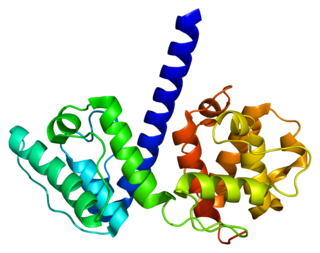
Plectin is a giant protein found in nearly all mammalian cells which acts as a link between the three main components of the cytoskeleton: actin microfilaments, microtubules and intermediate filaments. In addition, plectin links the cytoskeleton to junctions found in the plasma membrane that structurally connect different cells. By holding these different networks together, plectin plays an important role in maintaining the mechanical integrity and viscoelastic properties of tissues.

Stathmin, also known as metablastin and oncoprotein 18 is a protein that in humans is encoded by the STMN1 gene.
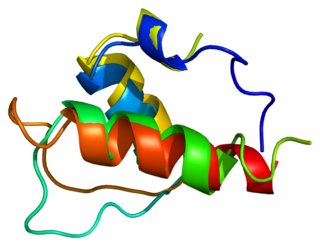
Lamina-associated polypeptide 2 (LAP2), isoforms beta/gamma is a protein that in humans is encoded by the TMPO gene. LAP2 is an inner nuclear membrane (INM) protein.
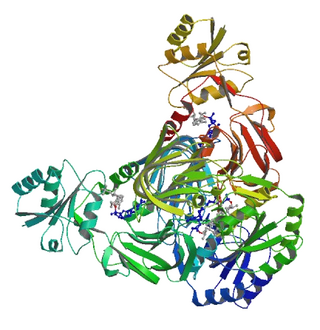
NAD+ kinase (EC 2.7.1.23, NADK) is an enzyme that converts nicotinamide adenine dinucleotide (NAD+) into NADP+ through phosphorylating the NAD+ coenzyme. NADP+ is an essential coenzyme that is reduced to NADPH primarily by the pentose phosphate pathway to provide reducing power in biosynthetic processes such as fatty acid biosynthesis and nucleotide synthesis. The structure of the NADK from the archaean Archaeoglobus fulgidus has been determined.

Class III β-tubulin, otherwise known as βIII-tubulin (β3-tubulin) or β-tubulin III, is a microtubule element of the tubulin family found almost exclusively in neurons, and in testis cells. In humans, it is encoded by the TUBB3 gene.

Microtubule-associated protein 2 is a protein in humans that is encoded by the MAP2 gene.

Microtubule-associated protein 4 is a protein that in humans is encoded by the MAP4 gene.

Tubulin beta-2A chain is a protein that in humans is encoded by the TUBB2A gene.

Guanine nucleotide-binding protein G(i), alpha-1 subunit is a protein that in humans is encoded by the GNAI1 gene.
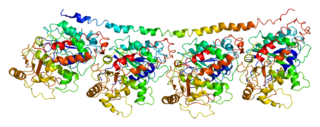
Tubulin alpha-4A chain is a protein that in humans is encoded by the TUBA4A gene.

—
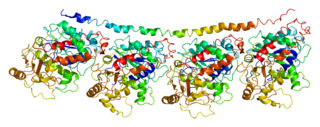
Tubulin alpha-1A chain is a protein that in humans is encoded by the TUBA1A gene.

Tubulin alpha-1B chain is a protein that in humans is encoded by the TUBA1B gene.
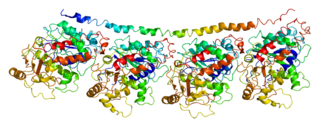
Tubulin alpha-3C/D chain is a protein that in humans is encoded by the TUBA3C gene.
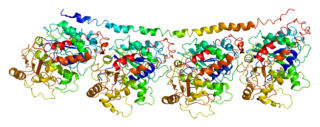
Tubulin beta-4B chain formerly known as tubulin beta-2C chain is a protein that in humans is encoded by the TUBB4B gene. It is thought that this protein could determine which hand is dominant in humans due to variations of the TUBB4B gene, which cause the protein to form microtubules that form cilia which direct fluids asymmetrically during development.

Tubulin beta-4A chain is a protein that in humans is encoded by the TUBB4A gene. Two tubulin beta-4 chain proteins are encoded in the human genome by the genes TUBB4A and TUBB4B. Tubulin is the major constituent of microtubules, a key components of the cytoskeleton. It binds two molecules of GTP, one at an exchangeable site on the beta-chain and one at a non-exchangeable site on the alpha-chain. TUBB4A is preferentially and highly expressed in the central nervous system.

ADP-ribosylation factor-like protein 3 is a protein that in humans is encoded by the ARL3 gene.

Pericentrin (kendrin), also known as PCNT and pericentrin-B (PCNTB), is a protein which in humans is encoded by the PCNT gene on chromosome 21. This protein localizes to the centrosome and recruits proteins to the pericentriolar matrix (PCM) to ensure proper centrosome and mitotic spindle formation, and thus, uninterrupted cell cycle progression. This gene is implicated in many diseases and disorders, including congenital disorders such as microcephalic osteodysplastic primordial dwarfism type II (MOPDII) and Seckel syndrome.

Adenylyl cyclase type 2 is an enzyme typically expressed in the brain of humans, that is encoded by the ADCY2 gene. It belongs to the adenylyl cyclase class-3 or guanylyl cyclase family because it contains two guanylate cyclase domains. ADCY2 is one of ten different mammalian isoforms of adenylyl cyclases. ADCY2 can be found on chromosome 5 and the "MIR2113-POU3F2" region of chromosome 6, with a length of 1091 amino-acids. An essential cofactor for ADCY2 is magnesium; two ions bind per subunit.
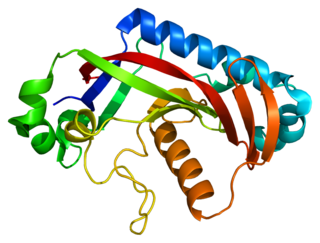
2′,3′-Cyclic-nucleotide 3'-phosphodiesterase is an enzyme that in humans is encoded by the CNP gene.